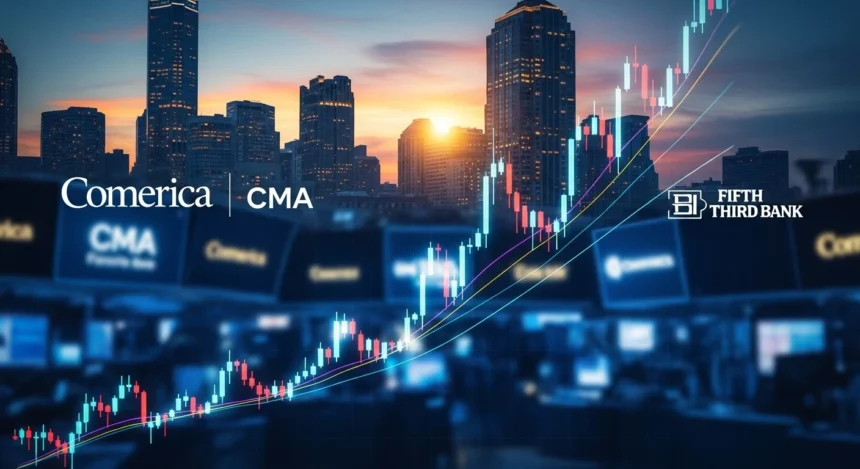On October 6, 2025, the U.S. banking sector witnessed a major shake-up as Fifth Third Bancorp (FITB) announced plans to acquire Comerica Inc. (CMA) in a $10.9 billion all-stock deal. The news immediately sent Comerica’s shares soaring, sparking debate among investors: after the jump, is CMA still a smart buy – or has the upside already been priced in?
Let’s break down the deal, analyze the numbers, and explore what this merger could mean for investors.
Deal Overview
The acquisition is an all-stock transaction that will create one of the nation’s largest regional banks.
Key Details:
- Deal Value: $10.9 billion
- Exchange Ratio: Comerica shareholders will receive 1.8663 shares of Fifth Third for each Comerica share.
- Implied Price per Share: Approximately $82.88, based on Fifth Third’s pre-announcement stock price.
- Premium Offered: Around 20% above Comerica’s 10-day average trading price before the deal.
- Ownership Split: Fifth Third shareholders will hold about 73% of the combined company, while Comerica investors will own roughly 27%.
- Combined Assets: Roughly $288 billion, making the new institution the ninth-largest U.S. bank.
- Expected Closing: By Q1 2026, pending regulatory and shareholder approvals.
Both banks describe the merger as a complementary fit – combining Fifth Third’s robust retail and digital banking network with Comerica’s established middle-market commercial banking base.
Market Reaction
The market’s initial response was swift and decisive.
- Comerica (CMA) surged between 12% and 14% on the day of the announcement, reflecting investor optimism and enthusiasm for the premium.
- Fifth Third (FITB) dipped slightly, down a few percent, as investors factored in dilution risk and the challenges of integrating two sizable regional franchises.
- The broader regional banking index rose modestly, indicating a wave of optimism that the deal could trigger further consolidation across the sector.
For Comerica shareholders, this jump effectively priced in much of the merger premium – but it also raised questions about whether there’s still meaningful upside ahead.
Comerica’s Pre-Deal Fundamentals
Before the announcement, Comerica’s financial profile showed a stable but unspectacular growth story.
Snapshot of key ratios:
- Price-to-Earnings (P/E): Around 13x
- Price-to-Book (P/B): Roughly 1.3x
- Return on Equity (ROE): About 11%
- Return on Assets (ROA): Around 0.9%
- Dividend Yield: Near 4%
Comerica was profitable, conservatively managed, and valued reasonably – but it lacked a clear growth catalyst. The deal, therefore, injects new life into its long-term outlook by providing scale, efficiency, and exposure to faster-growing markets.
Why the Deal Makes Strategic Sense
1. Scale and Efficiency
By combining back-office operations, technology platforms, and overlapping branch networks, the new entity aims to cut costs and unlock operational synergies. Management expects the deal to be accretive to earnings from day one.
2. Geographic Expansion
The merger deepens Fifth Third’s reach into the Sun Belt and West Coast, particularly in Texas and California, while maintaining a strong Midwest presence. Together, the banks will operate in 17 of the 20 fastest-growing U.S. markets.
3. Revenue Diversification
Both companies will benefit from two high-margin, fee-driven businesses – Commercial Payments and Wealth & Asset Management – each generating roughly $1 billion in annual revenue. This helps reduce dependence on interest-income cycles.
4. Stronger Competitive Position
With national megabanks and fintechs crowding the landscape, scale is now a survival strategy. The merger gives the combined firm a bigger balance sheet and better leverage in lending, technology, and regional dominance.
Risks to Watch
No merger is without risk – and this one has several.
- Integration Challenges
Blending IT systems, compliance departments, and company cultures is complex. Delays or missteps could erode projected cost savings. - Regulatory Uncertainty
Large bank mergers attract scrutiny from the FDIC, Federal Reserve, and Justice Department. Unexpected conditions or delays could extend the closing timeline. - Dilution & Share Price Volatility
Since the deal is all-stock, any drop in Fifth Third’s share price will reduce the effective value Comerica shareholders receive. - Synergy Overestimation
Many bank mergers fail to realize the cost savings and revenue synergies they promise. Even minor shortfalls can impact long-term profitability. - Macro & Credit Risks
Regional banks remain sensitive to credit cycles and interest-rate movements. A shift in loan demand or economic conditions could dampen near-term results. - Deal Failure Risk
Though unlikely, the deal could still fall through due to regulatory, legal, or shareholder opposition – a scenario that would likely push CMA’s price lower.
Is CMA Still a Buy?
Now that the stock has surged, should investors still consider buying?
Bull Case — Buy
You believe the merger will be approved and deliver strong synergies. You see the combined bank as a regional powerhouse with improved profitability and scale. The current price is a gateway to owning a larger, more resilient financial franchise.
Base Case — Hold
You think most of the upside is already baked in. The stock might see limited movement until the merger closes. You prefer to hold through the transition, collecting dividends while awaiting post-deal clarity.
Bear Case — Take Profits
You worry about integration challenges, regulatory risk, or a prolonged approval process. With the stock already reflecting the premium, you’d rather secure gains now and possibly revisit after the deal is finalized.
Verdict:
At current levels, CMA looks more like a hold than a fresh buy. The upside potential hinges on smooth execution – but given the deal size and regulatory complexity, it’s wise to stay cautiously optimistic rather than overly aggressive.
What’s Next for Investors
Keep an eye on these upcoming milestones:
- Shareholder Votes – Approval from both Comerica and Fifth Third investors.
- Regulatory Review – Scrutiny from federal and state banking regulators.
- Quarterly Earnings Updates – Any new guidance or synergy progress reports.
- Integration Announcements – Early indications of system alignment or cost reductions.
- Fifth Third’s Stock Performance – Since CMA’s final value depends on FITB’s stock, volatility there directly impacts CMA holders.
Final Thoughts
The Fifth Third–Comerica merger is the most significant regional banking deal of 2025, signaling that scale and diversification are the new currency of survival. Comerica shareholders have already captured substantial gains from the announcement, but long-term success now depends on flawless execution.
If you already hold CMA, staying put makes sense while the dust settles. If you’re looking to enter fresh, patience could pay off – wait for clarity on approvals and early post-merger performance before making a move.
Bottom Line:
CMA’s rally is justified, but its next move depends less on speculation and more on execution. Smart investors will watch the integration closely – because in modern banking, synergy is easy to promise and hard to deliver.








